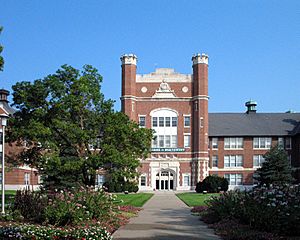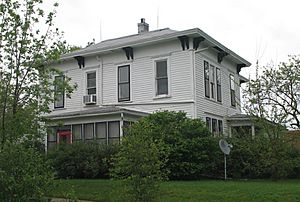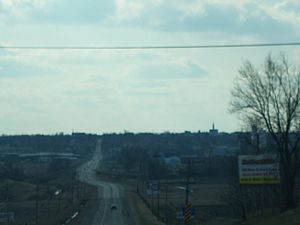Maryville, Missouri facts for kids
Quick facts for kids
Maryville, Missouri
|
|
|---|---|
|
City
|
|
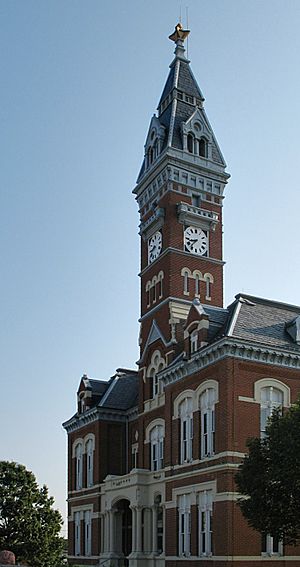
Nodaway County Courthouse, 2006
|
|
| Nickname(s):
Title Town
|
|
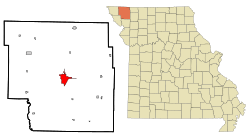
Location within Nodaway County and Missouri
|
|

U.S. Census Map of Maryville
|
|
| Country | United States |
| State | Missouri |
| County | Nodaway |
| Township | Polk |
| Platted | 1845 |
| Government | |
| • Type | Mayor–Council |
| Area | |
| • Total | 6.41 sq mi (16.59 km2) |
| • Land | 6.37 sq mi (16.51 km2) |
| • Water | 0.03 sq mi (0.08 km2) |
| Elevation | 1,106 ft (337 m) |
| Population
(2020)
|
|
| • Total | 10,633 |
| • Density | 1,668.18/sq mi (644.06/km2) |
| Time zone | UTC-6 (CST) |
| • Summer (DST) | UTC-5 (CDT) |
| ZIP code |
64468
|
| Area code | 660 |
| FIPS code | 29-46640 |
| GNIS feature ID | 2395037 |
Maryville is a city in Nodaway County, Missouri, in the United States. It is the main city, or county seat, of Nodaway County. In 2020, about 10,633 people lived there.
Maryville is special because it is home to Northwest Missouri State University and Northwest Technical School. It is also known as "Title Town" because its sports teams have won many championships!
Contents
- History of Maryville
- Geography and Climate
- Population of Maryville
- Fun Places to Visit
- Recreation and Parks
- Education in Maryville
- Media and Radio
- Transportation
- Notable People from Maryville
- Images for kids
- See also
History of Maryville
Maryville was officially planned out on September 1, 1845. The city was named after Mary, the wife of Amos Graham. He was the town's first postmaster and an early settler. Graham also helped organize Nodaway County in 1845. Maryville was chosen as the county seat because it is near the center of the county.
The first house in Maryville was built by Jack (John) Saunders. The first courthouse was built in 1846. The current courthouse was built in 1881. It has a sculpture of a pineapple, which is a sign of welcome.
The city became an official town in 1856. It was formally incorporated on July 19, 1869. This happened when the Kansas City, St. Joseph, and Council Bluffs Railroad arrived. Another railroad, the Wabash Railroad, arrived in 1879.
Famous Governors from Maryville
Maryville has been home to two Missouri governors. In 1872, Albert P. Morehouse started a newspaper called the Nodaway Democrat. He later became a governor. The house he lived in was later occupied by Forrest C. Donnell, who also became a governor and a U.S. Senator!
Cool Inventions and Hospitals
In 1889, the Maryville Methodist Seminary opened. In 1891, Elizabeth Howell from Maryville helped improve the Lazy Susan. She got a patent for her "Self-Waiting Tables." Her design made the Lazy Susan work more smoothly. In 1894, Mary Augustine Giesen opened St. Francis Hospital in Maryville.
Kentucky Derby Champions
Maryville has a cool connection to the Kentucky Derby, a famous horse race! In 1901, a horse named Elwood was born at Faustiana Farms in Maryville. He won the Kentucky Derby in 1904. He was the first Derby winner bred by a woman! Another Derby winner, Black Gold, was also connected to Faustiana Farms.
Trainers Ben A. Jones and his son Jimmy Jones also had strong ties to Nodaway County. They won many Kentucky Derby races. You can see items from their horse racing days at the Nodaway County Historical Society Museum.
Northwest Missouri State University
In 1905, Maryville won a competition to get the Fifth District Normal School. This school later became Northwest Missouri State University. The city offered land and money to the state for the school. The college is on the northwest side of the city. The Thomas Gaunt mansion, the college President's home, is on the National Register of Historic Places. The land around it is now the Missouri Arboretum, a beautiful garden with many trees.
Presidents and Maryville
Maryville has connections to two U.S. Presidents!
Herbert Hoover's Farm
In 1928, people thought Maryville might become the "Western White House" for Herbert Hoover. This was because he owned a farm south of town. He visited his farm in 1933 after he was no longer president.
Harry Truman's Connections
Harry S. Truman, another U.S. President, visited Maryville many times. His last visit was in 1962 when he dedicated the new post office. Truman had strong ties to Maryville because he was part of the 129th Field Artillery Regiment in the Missouri National Guard, which was based in Maryville. He commanded Battery D during World War I. The 129th's motto is "Truman's Own" because of him!
Maryville Today
In 1969, Maryville received an All-America City Award. This award recognizes cities that work together to solve problems and improve their communities.
Since 1987, Maryville has hosted the "World's Shortest Saint Patrick's Day Parade." It's a fun event that's less than a block long! They even pour green water from a garbage truck, like the Chicago River.
In 1994, Mozingo Lake opened east of Maryville. It has a golf course designed by famous golfers like Donald Sechrest and Tom Watson.
Sports Champions: "Title Town"
Maryville earned its nickname "Title Town" because of its amazing sports teams!
College Football and Basketball
The Northwest Missouri State Bearcats football team became very strong in 1994. They played in many NCAA Division II Football Championship games, winning in 1998, 1999, 2009, 2013, 2015, and 2016. The basketball team also won national titles in 2017, 2019, and 2021.
High School Football
The Maryville High School football team has also won many state championships. They won in 1982, 2009, 2012, 2013, and 2017. The high school mascot is unique: the "Spoofhounds"! Both the college and high school teams wear green and white.
Minor League Baseball
Maryville also had its own minor league baseball team called the Maryville Comets in 1910 and 1911. They played in the Class D level Missouri-Iowa-Nebraska-Kansas League.
Geography and Climate
Maryville is about 40 miles (64 km) north of St. Joseph, Missouri. The city covers about 5.80 square miles (15.02 km2). Most of this area is land, with a small amount of water. The One Hundred and Two River is on the east side of the city. It provides power and water for Maryville.
Maryville has a humid continental climate. This means it has hot, humid summers and cold winters.
| Climate data for Maryville, Missouri (1991–2020 normals, extremes 1895–present) | |||||||||||||
|---|---|---|---|---|---|---|---|---|---|---|---|---|---|
| Month | Jan | Feb | Mar | Apr | May | Jun | Jul | Aug | Sep | Oct | Nov | Dec | Year |
| Record high °F (°C) | 69 (21) |
80 (27) |
92 (33) |
96 (36) |
110 (43) |
105 (41) |
112 (44) |
113 (45) |
107 (42) |
99 (37) |
84 (29) |
71 (22) |
113 (45) |
| Mean maximum °F (°C) | 56.5 (13.6) |
62.0 (16.7) |
75.6 (24.2) |
84.7 (29.3) |
89.6 (32.0) |
94.0 (34.4) |
96.3 (35.7) |
95.7 (35.4) |
91.9 (33.3) |
85.9 (29.9) |
71.7 (22.1) |
60.6 (15.9) |
98.0 (36.7) |
| Mean daily maximum °F (°C) | 33.8 (1.0) |
38.9 (3.8) |
51.5 (10.8) |
63.2 (17.3) |
73.3 (22.9) |
83.0 (28.3) |
86.7 (30.4) |
85.2 (29.6) |
78.4 (25.8) |
66.1 (18.9) |
50.7 (10.4) |
38.5 (3.6) |
62.4 (16.9) |
| Daily mean °F (°C) | 23.8 (−4.6) |
28.4 (−2.0) |
40.2 (4.6) |
51.2 (10.7) |
62.4 (16.9) |
72.3 (22.4) |
76.1 (24.5) |
74.0 (23.3) |
66.0 (18.9) |
53.7 (12.1) |
40.0 (4.4) |
28.8 (−1.8) |
51.4 (10.8) |
| Mean daily minimum °F (°C) | 13.9 (−10.1) |
17.9 (−7.8) |
28.9 (−1.7) |
39.2 (4.0) |
51.5 (10.8) |
61.6 (16.4) |
65.6 (18.7) |
62.9 (17.2) |
53.7 (12.1) |
41.3 (5.2) |
29.2 (−1.6) |
19.2 (−7.1) |
40.4 (4.7) |
| Mean minimum °F (°C) | −8.1 (−22.3) |
−1.7 (−18.7) |
9.4 (−12.6) |
24.6 (−4.1) |
38.1 (3.4) |
50.0 (10.0) |
55.8 (13.2) |
53.0 (11.7) |
39.2 (4.0) |
25.9 (−3.4) |
13.2 (−10.4) |
−0.8 (−18.2) |
−12.6 (−24.8) |
| Record low °F (°C) | −32 (−36) |
−28 (−33) |
−26 (−32) |
4 (−16) |
18 (−8) |
38 (3) |
42 (6) |
39 (4) |
22 (−6) |
2 (−17) |
−11 (−24) |
−28 (−33) |
−32 (−36) |
| Average precipitation inches (mm) | 0.89 (23) |
1.20 (30) |
2.31 (59) |
3.98 (101) |
5.47 (139) |
4.97 (126) |
5.33 (135) |
4.22 (107) |
3.52 (89) |
3.01 (76) |
1.98 (50) |
1.49 (38) |
38.37 (975) |
| Average snowfall inches (cm) | 5.2 (13) |
4.4 (11) |
1.6 (4.1) |
0.8 (2.0) |
0.0 (0.0) |
0.0 (0.0) |
0.0 (0.0) |
0.0 (0.0) |
0.0 (0.0) |
0.1 (0.25) |
0.6 (1.5) |
2.6 (6.6) |
15.3 (39) |
| Average precipitation days (≥ 0.01 in) | 5.5 | 6.1 | 7.5 | 10.0 | 12.2 | 11.0 | 9.5 | 8.7 | 7.5 | 8.0 | 5.9 | 5.3 | 97.2 |
| Average snowy days (≥ 0.1 in) | 2.7 | 2.3 | 1.0 | 0.2 | 0.0 | 0.0 | 0.0 | 0.0 | 0.0 | 0.1 | 0.7 | 2.4 | 9.4 |
| Source: NOAA | |||||||||||||
Population of Maryville
| Historical population | |||
|---|---|---|---|
| Census | Pop. | %± | |
| 1860 | 427 | — | |
| 1870 | 1,682 | 293.9% | |
| 1880 | 3,485 | 107.2% | |
| 1890 | 4,037 | 15.8% | |
| 1900 | 4,577 | 13.4% | |
| 1910 | 4,762 | 4.0% | |
| 1920 | 4,711 | −1.1% | |
| 1930 | 5,217 | 10.7% | |
| 1940 | 5,700 | 9.3% | |
| 1950 | 6,834 | 19.9% | |
| 1960 | 7,807 | 14.2% | |
| 1970 | 9,970 | 27.7% | |
| 1980 | 9,558 | −4.1% | |
| 1990 | 10,663 | 11.6% | |
| 2000 | 10,581 | −0.8% | |
| 2010 | 11,972 | 13.1% | |
| 2020 | 10,633 | −11.2% | |
| U.S. Decennial Census | |||
2020 Census Information
In 2020, the census counted 10,633 people living in Maryville. Most residents (89.01%) were White. About 2.26% were African American, and 3.28% were Asian. About 2.2% of the population was Hispanic or Latino.
The average age in Maryville was 22.9 years. This is because many young people attend the university there.
Fun Places to Visit
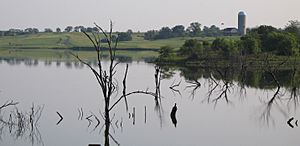
Maryville has many interesting places to see and visit:
- Missouri Academy of Science, Mathematics and Computing
- Missouri State Arboretum
- Mozingo Lake Park and Golf Course
- Nodaway County Historical Society Museum
- Northwest Missouri State University
- Kawasaki Heavy Industries Motorcycle & Engine has a factory that makes engines in town.
Several buildings in Maryville are listed on the National Register of Historic Places. These include the Administration Building, the Frank House, the Thomas Gaunt House, and the Nodaway County Courthouse.
Recreation and Parks
Maryville has ten city parks for everyone to enjoy! These parks include:
- Six baseball fields
- Soccer and football fields
- A skate park
- A nature park
- The Maryville Aquatic Center, which is a swimming pool facility.
The city also takes care of Mozingo Lake Park and its Golf Course. The golf course has 27 holes and is located near the lake.
Education in Maryville
Maryville offers great schools for all ages.
Schools for Kids and Teens
The Maryville R-II School District has three main buildings:
- Maryville High School (for grades 9–12)
- Maryville Middle School (for grades 5–8)
- Eugene Field Elementary School (for grades Pre-K–4)
Other schools in Maryville include:
- St. Gregory's Barbarigo School (for grades K–8)
- Horace Mann Laboratory School (for grades Pre-K–6)
Colleges and Universities
Maryville is home to Northwest Missouri State University. This is a large university where students can earn college degrees. North Central Missouri College also has a campus in Maryville at the Northwest Technical Center.
Public Library
Maryville has a public library called the Maryville Public Library. It is a great place to borrow books and learn new things.
Media and Radio
Maryville has several radio stations that you can listen to:
- KNIM – 1580 AM – Plays oldies music and local news.
- KZLX-LP – 106.7 FM – This is the student radio station for NWMSU.
- KVVL – 97.1 FM – Plays oldies, classic rock, and regional sports.
- KNIM 95.9 Pickup Country
- KXCV – 90.5 FM – This is NWMSU's main radio station. It plays classical and jazz music, and also broadcasts National Public Radio shows and NWMSU sports games.
- KBCT – 104.9 FM – Plays classic hits.
Transportation
Maryville has two main U.S. Highways: U.S. Routes 71 and 136. These highways meet on the east side of the city. A special branch of US 71, called U.S. Route 71 Business, acts as the main street through town. Other roads like Route 46, Route 148, and Route V also help people get around.
Maryville is also served by the Northwest Missouri Regional Airport. This airport is for general aviation, meaning it's used for private planes, not big commercial flights. You can also travel to Maryville by bus using Jefferson Lines.
Notable People from Maryville
Many interesting people have come from Maryville, including:
- Sarah Caldwell – A famous opera singer.
- Dale Carnegie – The author of the well-known book How to Win Friends and Influence People.
- Homer Croy – An author and screenwriter who wrote stories about life in Maryville.
- Albert David – A hero who received the Medal of Honor during World War II.
- Forrest C. Donnell – A former Governor of Missouri.
- Adam Dorrel – A highly successful college football coach.
- Elwood – A horse born in Maryville who won the Kentucky Derby.
- Jane Hall Johnson - An engineer and architect.
- Horace A. "Jimmy" Jones – A famous horse trainer.
- Darius Kinsey – A photographer known for his pictures of the logging industry.
- Truman H. Landon – An Air Force General.
- Edward H. Moore – A U.S. Senator from Oklahoma.
- Albert P. Morehouse – Another former Governor of Missouri.
- Lynne Overman – An actor from the 1930s and 1940s.
- Jim Spainhower – A former State Treasurer.
- George S.E. Vaughn – A person accused of being a Confederate spy during the Civil War.
Images for kids
-
Nodaway County Courthouse, 2006
-
Location within Nodaway County and Missouri
See also
 In Spanish: Maryville (Misuri) para niños
In Spanish: Maryville (Misuri) para niños


